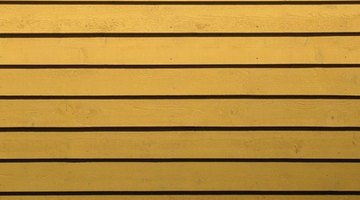Problems With Composite Siding
Composite siding is an exterior material used in homes and buildings. "Composite siding" can refer to a number of materials including fiber cement, asbestos and aluminum, but most often composite siding or engineered wood siding refers to wood products and byproducts like wood chips and saw dust that are compressed into boards. The problems associated with composite siding vary according to the specific make-up of the material.
Moisture

Composite siding is particularly susceptible to moisture. It is composed of severall materials that are pressed into a board; the space between components creates openings for moisture from rain, humidity or garden watering. If composite siding is installed improperly, spaces between boards can also allow moisture to penetrate the exterior of the building. Moisture can promote mold or fungal growth which deteriorate the product and pose a health risk if the spores are inhaled.
Installation
Manufacturers of composite siding advertise its ease of installation, but composite materials like fiber cement board come in heavy sheets. The sheets are cut to size on location; dust from cutting can cause respiratory irritation. The weight of the boards make them difficult to handle and install, increasing the likelihood of errors that can lead to further problems like moisture build-up or buckling.
Insulation
Exterior wall materials provide both thermal and sound insulation. Some composite materials like cement board do not provide adequate heat insulation. Engineered wood composites like hardboard may not provide adequate sound blocking. Poor insulation capabilities can lead to higher home heating and cooling costs which may defeat the benefit of low purchase and installation costs.
Irregularities
Wood siding and wood composite siding can mask warping or unevenness in the frame of a house. Cement composite siding, however, does not have the same capabilities. If the frame of a house contains any bumps or irregularities, they will not be masked by cement fiber boards. If the boards are not properly installed, they have the potential to buckle or warp due to heat or moisture. The boards can also swell from water damage; swelling can cause cracks in the siding or cause the outside of the house to appear warped.
References
Writer Bio
Hannah Wahlig began writing and editing professionally in 2001. Her experience includes copy for newspapers, journals and magazines, as well as book editing. She is also a certified lactation counselor. She holds a Bachelor of Arts in English from Mount Holyoke College, and Master's degrees in education and community psychology from the University of Massachusetts.
Photo Credits
- Yellow Wall image by steverts from Fotolia.com
More Articles



